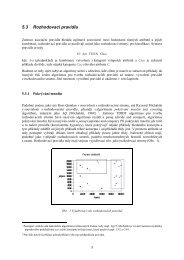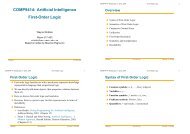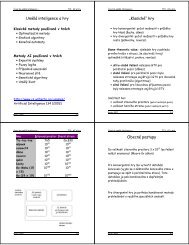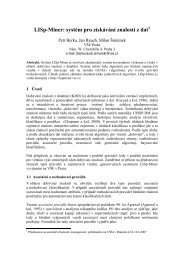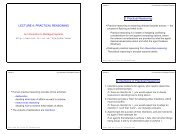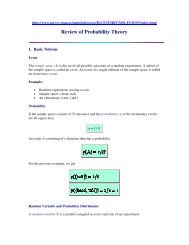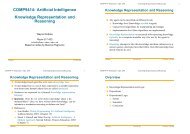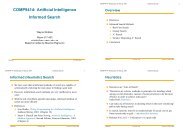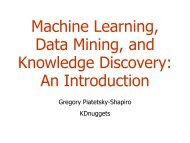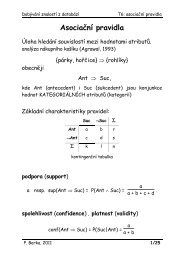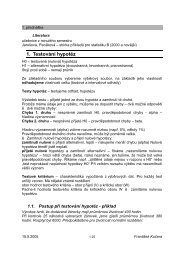Fuzzy Logic - Sorry
Fuzzy Logic - Sorry
Fuzzy Logic - Sorry
You also want an ePaper? Increase the reach of your titles
YUMPU automatically turns print PDFs into web optimized ePapers that Google loves.
AI Module<br />
Defuzzification<br />
APGDST<br />
It converts the fuzzy value into a "crisp" value. This<br />
process is often complex since the resulting fuzzy set might<br />
not translate directly into a crisp value. Physical systems<br />
need discrete values and hence Defuzzification is important.<br />
The different methods of Defuzzification are<br />
1) Max-Membership Principle: This method chooses the<br />
element with the maximum value.<br />
µ ( z<br />
* ) ≥ ( z)<br />
c<br />
µ<br />
c<br />
AI Module<br />
z<br />
*<br />
=<br />
∑<br />
∑<br />
z<br />
c<br />
*<br />
=<br />
µ ( z)<br />
c<br />
Defuzzification<br />
∫<br />
∫<br />
µ ( z).<br />
zdz<br />
c<br />
µ ( z)<br />
dz<br />
c<br />
APGDST<br />
2) Centroid Method: The centroid defuzzification method finds the “balance”<br />
point of the solution fuzzy region by calculating the weighted mean of the output<br />
fuzzy region.<br />
3) Weighted Average Method: The weighted average method is formed by<br />
weighting each membership function in the output by its respective maximum<br />
membership value.<br />
µ ( z)<br />
z<br />
z<br />
*<br />
a(0.5)<br />
=<br />
0.5<br />
+<br />
+<br />
b(0.9)<br />
0.9<br />
© NCST, 2002 <strong>Fuzzy</strong> <strong>Logic</strong><br />
17<br />
© NCST, 2002 <strong>Fuzzy</strong> <strong>Logic</strong><br />
18<br />
AI Module<br />
Linguistic Hedges<br />
APGDST<br />
n Hedges are modifiers of fuzzy values and allow generation of<br />
fuzzy statements through mathematical calculations.<br />
n Hedges act on fuzzy set’s membership function to modify it.<br />
Hedges play the same role in <strong>Fuzzy</strong> production rules that<br />
adjectives and adverbs play in English sentences.<br />
AI Module<br />
Concentrator hedge intensifies the<br />
fuzzy region.<br />
n<br />
µ ( x)<br />
= µ ( x)<br />
con ( A)<br />
A<br />
where n>=1.<br />
Linguistic Hedges<br />
APGDST<br />
n Depending on their impact on the membership function, the<br />
hedges are classified as concentrators, dilators and contrast<br />
hedges.<br />
Dilator hedge which dilutes the<br />
force of fuzzy set membership<br />
function. .<br />
1 /<br />
µ ( x)<br />
= µ<br />
dil ( A )<br />
A<br />
n<br />
( x)<br />
In the fig. “very warm” represents the concentrator<br />
And “rather warm” represents dilator<br />
© NCST, 2002 <strong>Fuzzy</strong> <strong>Logic</strong><br />
19<br />
© NCST, 2002 <strong>Fuzzy</strong> <strong>Logic</strong><br />
20



